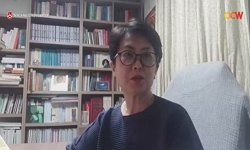Background/significance. Cardiovascular disease (CVD) kills more women than any other cause of death. However, black women are more likely than white women to underestimate their risk for CVD and less likely to participate in leisure-time physical ac...
http://chineseinput.net/에서 pinyin(병음)방식으로 중국어를 변환할 수 있습니다.
변환된 중국어를 복사하여 사용하시면 됩니다.
- 中文 을 입력하시려면 zhongwen을 입력하시고 space를누르시면됩니다.
- 北京 을 입력하시려면 beijing을 입력하시고 space를 누르시면 됩니다.
https://www.riss.kr/link?id=T12299077
- 저자
-
발행사항
[S.l.]: University of Arkansas for Medical Sciences 2009
-
학위논문사항
-
-
발행연도
-
-
작성언어
영어
- 주제어
-
0
상세조회 -
0
다운로드
부가정보
다국어 초록 (Multilingual Abstract)
Methods. An ethnographic design was used to explore EMs of CVD of 20 southern rural black women with at least 1 modifiable risk factor for CVD. Participants were recruited using convenience sampling at monthly staff meetings at a long-term care facility [n=14]. The other 6 participants were recruited through snowball sampling. Individual in-depth semi-structured audiotaped interviews were conducted primarily in women's homes. Descriptive statistics, content analysis, and constant comparison were used to analyze data.
Results. Participants were 40 to 58 years, and 19 of 20 were overweight. Other risk factors included: hypertension [n=14] and dyslipidemia [n=7]. Ten reported walking 1 to 2 times a week; only 3 reported LTPA at recommended levels. Although participants were queried about CVD, they focused solely on heart disease. Qualitative data revealed 3 factors of the "Causes of Heart Disease": (1) Lifestyle- "[E]atin' a lot of greasy food." (2) Physiologic Causes- "[P]eople that have diabetes will have heart problems." and (3) Going to Get It- "[A woman] can't prevent it if it's hereditary;" and 4 factors of women's "Thoughts about Physical Activity": (1) Thoughts about How Exercise Affects the Heart - "I would say it [exercise] wouldn't help them not to get it. I feel like it wouldn't be as bad." (2) Barriers to Exercise- "I just don't have the energy to exercise." (3) Reasons to Exercise - "It's a stress reliever for me to be able to walk." and (4) Taking Action- "I don't do it [exercise] as often as I should.".
Discussion. Misconceptions regarding the inevitability of CVD, incongruous thoughts about the role of LTPA, and lack of personalization of CVD risk indicate that further education is needed, as is the development of interventions to assist women to increase LTPA.
Background/significance. Cardiovascular disease (CVD) kills more women than any other cause of death. However, black women are more likely than white women to underestimate their risk for CVD and less likely to participate in leisure-time physical activity (LTPA). Increasing LTPA can potentially decrease the risk for CVD. The purpose of this study was to explore black women's explanatory models (EMs) of the etiology, risk, and prevention of CVD.
Methods. An ethnographic design was used to explore EMs of CVD of 20 southern rural black women with at least 1 modifiable risk factor for CVD. Participants were recruited using convenience sampling at monthly staff meetings at a long-term care facility [n=14]. The other 6 participants were recruited through snowball sampling. Individual in-depth semi-structured audiotaped interviews were conducted primarily in women's homes. Descriptive statistics, content analysis, and constant comparison were used to analyze data.
Results. Participants were 40 to 58 years, and 19 of 20 were overweight. Other risk factors included: hypertension [n=14] and dyslipidemia [n=7]. Ten reported walking 1 to 2 times a week; only 3 reported LTPA at recommended levels. Although participants were queried about CVD, they focused solely on heart disease. Qualitative data revealed 3 factors of the "Causes of Heart Disease": (1) Lifestyle- "[E]atin' a lot of greasy food." (2) Physiologic Causes- "[P]eople that have diabetes will have heart problems." and (3) Going to Get It- "[A woman] can't prevent it if it's hereditary;" and 4 factors of women's "Thoughts about Physical Activity": (1) Thoughts about How Exercise Affects the Heart - "I would say it [exercise] wouldn't help them not to get it. I feel like it wouldn't be as bad." (2) Barriers to Exercise- "I just don't have the energy to exercise." (3) Reasons to Exercise - "It's a stress reliever for me to be able to walk." and (4) Taking Action- "I don't do it [exercise] as often as I should.".
Discussion. Misconceptions regarding the inevitability of CVD, incongruous thoughts about the role of LTPA, and lack of personalization of CVD risk indicate that further education is needed, as is the development of interventions to assist women to increase LTPA.









